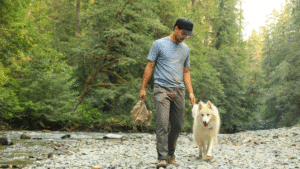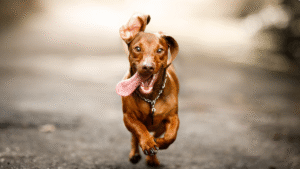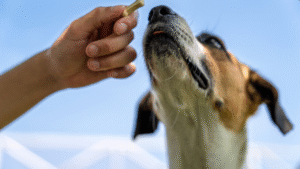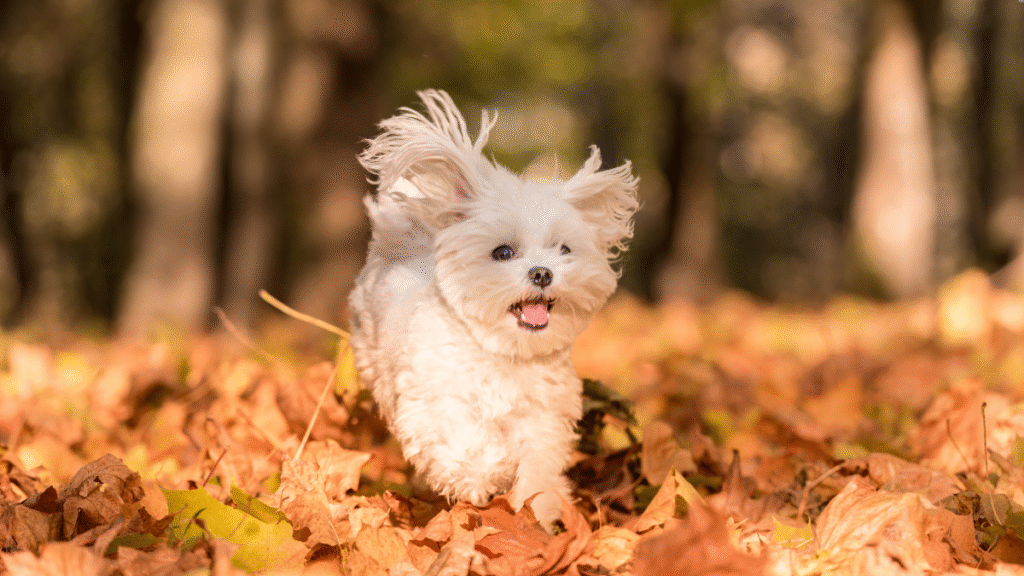Walking your dog should be a peaceful, pleasant experience for you both — not an exhausting battle of wills. But if you have a hyper dog that pulls on the leash, lunges, or barks at every passing squirrel, walk time can quickly become a hassle instead of an enjoyable activity.
Many dog owners struggle with overly excited walking behavior and wonder how to turn that wriggling, overstimulated ball of energy into a calm, focused walking partner.

Why Your Dog Is So Hyper on Walks
Hyperactive walking behavior is usually the result of several common factors. Most dogs aren’t being “bad” or disobedient on purpose — they’re simply displaying normal dog behavior in response to excitement, lack of exercise, or overstimulation.
Here are the most common reasons dogs act hyper on walks:
1. Lack of exercise or mental stimulation:
Active dogs need regular physical and mental exercise. If they don’t get it throughout the day, they’ll often release that pent-up energy the moment the leash comes out.
2. Overstimulation:
The outdoors is a sensory buffet of sights, sounds, and smells. Many dogs, especially younger ones, can become overwhelmed by all that stimulation and act out as a result.
3. Inconsistent leash training:
Some dogs become overexcited or pull on the leash because they’ve learned that it works — pulling gets them where they want to go.
4. Anxiety or fear-based behavior:
Anxious or fearful dogs may act hyperactively on leash as a way to cope with environments that make them uncomfortable.
5. Breed tendencies:
Certain breeds naturally have higher energy levels and drive. Working breeds, herding dogs, and terriers often need more structure and focus during walks than others.
Identifying the cause of your dog’s overexcited behavior helps you choose the most effective training strategies to correct it.
Step 1: Start With the Right Mindset
One of the easiest ways to improve your walks is to change your mindset. Dogs are very tuned in to our emotions and energy levels. If you start a walk feeling tense, frustrated, or impatient, your dog will sense that energy and mirror it.
Before each walk, take a few deep breaths and remind yourself to stay calm and consistent. Don’t expect perfection — the goal isn’t that your dog never pulls or barks again, but that your walks steadily improve over time through patience and persistence.
Step 2: Set the Stage Indoors
For some dogs, simply seeing the leash triggers a burst of excitement. This “leash reactivity” can be prevented by teaching your dog calm behavior indoors first.
Break the leash-excitement association by:
-
Picking up the leash several times a day but waiting to clip it on until your dog is calm.
-
Practicing calm exits: don’t open the door until your dog sits quietly, even if that means stepping back and trying again.
-
Following a consistent pre-walk routine — leash on, sit, wait, open the door, release command, walk.
Training your dog to remain calm before leaving the house sets the tone for the entire walk.
Step 3: Use the Right Walking Equipment
The right walking gear can make a big difference in managing a hyper dog. Comfort, safety, and control are essential.
Recommended tools:
-
Front-clip harness: Redirects pulling and gives you greater control without choking your dog.
-
Head halter (gentle leader): Guides your dog’s head and reduces lunging but should be introduced gradually and positively.
-
Standard 4–6 foot leash: Avoid retractable leashes — they create constant tension and encourage pulling.
No tool will work perfectly without training. Equipment should support your efforts, not replace them.
Step 4: Tire Them Out Before the Walk
Burning off some energy before the walk can make a huge difference in your dog’s behavior. A short play session or mental exercise can help your dog start the walk in a calmer state.
Pre-walk activities that work:
-
A quick game of fetch in the yard.
-
Scent or puzzle games indoors.
-
A few minutes of basic obedience practice (sit, down, stay).
A little mental or physical exercise beforehand helps your dog approach the walk more relaxed and focused.

Step 5: Teach Loose Leash Walking
Loose leash walking — walking without tension on the leash — is the foundation of calm walking. This skill takes practice but is essential for long-term success.
How to teach it:
-
Start in a low-distraction area and use treats to reward your dog for walking beside you with a loose leash.
-
Stop immediately when your dog pulls. Don’t yank or scold. Simply stop moving and wait until the leash slackens before continuing.
-
Change direction often to keep your dog’s attention focused on you rather than the environment.
Dogs learn loose leash walking faster when you practice consistently and reward calm behavior frequently.
Step 6: Practice Impulse Control
Impulse control is crucial for dogs that get overly excited on walks. Teaching patience and self-control improves both obedience and calmness outdoors.
Impulse control exercises:
-
Sit and wait before crossing streets or greeting people.
-
Leave it when encountering distractions such as food, squirrels, or other dogs.
-
Look at me to train your dog to make eye contact with you when something exciting appears.
Regularly practicing these exercises helps your dog stay calmer and more focused during walks.
Step 7: Use Positive Reinforcement
Positive reinforcement — rewarding your dog for desired behavior — is the most effective and humane way to train. Punishment or harsh corrections often increase anxiety and reactivity.
Tips for effective reinforcement:
-
Reward good behavior immediately with treats, praise, or petting.
-
Find the rewards that motivate your dog most.
-
Be consistent — reward calm, focused walking every time it happens.
Patience and consistency are key to positive reinforcement success.

Step 8: Manage Environmental Triggers
For some dogs, the main challenge isn’t energy but specific triggers during walks — such as other dogs, people, bikes, cars, or wildlife.
To manage triggers:
-
Maintain a safe distance from triggers until your dog remains calm.
-
Reward your dog for calm behavior when they see the trigger from afar.
-
Gradually reduce the distance as your dog becomes more relaxed.
Never force your dog into uncomfortable situations. Progress should happen at their pace.
Step 9: Keep Walks Short and Positive
In the early stages, shorter, positive walks are far better than long, stressful ones. If needed, take several short walks throughout the day instead of one long battle.
A calm five-minute walk is more productive than a thirty-minute struggle.
Step 10: Be Consistent and Patient
The key to calm walking is consistency and patience. It takes time, practice, and repetition for your dog to master leash manners.
Calm leash walking isn’t an overnight fix but a gradual process. Stay consistent in your training, and over time, you’ll have a walking partner who’s both calmer and happier.

Common Mistakes to Avoid
Avoid these common errors that often make hyper walking behavior worse:
-
Letting the dog lead the walk: This teaches your dog that pulling and excitement are acceptable.
-
Using retractable leashes: These create constant tension and encourage bad habits.
-
Punishing excitement: Punishment increases anxiety and often worsens behavior. Redirect to calm actions instead.
-
Inconsistent routines: Changing cues and expectations confuses your dog and slows progress.
Avoiding these mistakes will help make your training smoother and more effective.
Final Thoughts
Helping an overexcited dog become a calm walker isn’t about dominance or control — it’s about clear communication, patience, and consistency. Setting clear expectations, rewarding calm behavior, and managing your dog’s energy level will teach them that walks are a time for calmness and connection with you.
- 5 Cheap Alternatives To Dog Training Equipment - November 12, 2025
- Homemade Calming Spray To Help Dogs During Training - November 12, 2025
- 7 DIY Dog Training Tools You Can Make From Household Items - November 12, 2025
